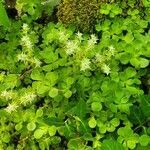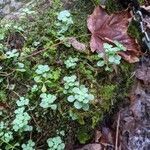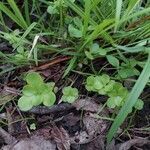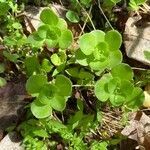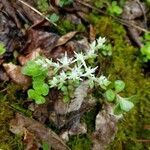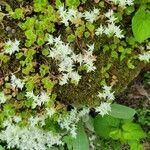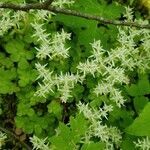Herbs, perennial, often mat-forming, glabrous. Stems de-cumbent, few-branched, (finely papillose), bearing terminal rosettes. Leaves in whorls of 3, rarely 2 or 4 or decussate, spreading to ascending, shortly petiolate or sessile; blade pale yellow-green to dark green, not glaucous, obovate to obovate-spatulate or elliptic, laminar, 10-17 × 7-11 mm, base truncately short-spurred, not scarious, apex truncate or rounded, sometimes emarginate, (surfaces finely papillose or crenulate). Flowering shoots erect, simple, 4-20 cm, (papillose); leaf blades obovate to obovate-spatulate or elliptic, base short-spurred; offsets not formed. Inflorescences cymes, 5-25-flowered, 3-branched, (sometimes papillose); branches recurved in bud, becoming ± erect at anthesis, not forked; bracts similar to leaves. Pedicels absent or to 1 mm, (papillose, almost glandular). Flowers 4(-6)-merous; sepals spreading to erect, connate basally, pale yellow-green, lanceolate-oblong or elliptic, equal, 2.4-5 × 0.8-1.7 mm, apex obtuse, (finely papillose); petals erect to spreading, distinct, white, elliptic-lanceolate, abaxially carinate, adaxially channeled, 5.4-8.9 mm, apex acute; filaments white, (flattened basally); anthers red or purple; nectar scales yellow or pale yellow, oblong or subquadrate. Carpels widely divergent in fruit, distinct, brown. 2n = 32.
More
Fibrous-rooted perennial from creeping stems, sending up usually a single flowering stem 1–2 dm and several short, leafy, sterile shoots; lvs green, those of the sterile shoots and the lower ones of the fertile shoots mostly in whorls of 3(4), obovate, 1–2 cm long, often 1 cm wide, entire, cuneate to the base; upper lvs of fertile stems opposite or sometimes alternate, oblanceolate to nearly linear; infl of 2–4 divergent, secund, sympodial cymes; fls mostly 4-merous; pet white, widely spreading, 5–9 mm; filaments only very shortly adnate to the pet; frs divaricate; 2n=16, 24, 32, 48. Rocks, cliffs and woods; N.J. to n. Ga., w. to Io. and Ark., and occasionally escaped n. to N. Engl., N.Y., and s. Mich. May, June.
